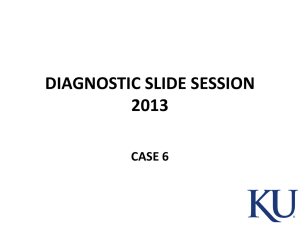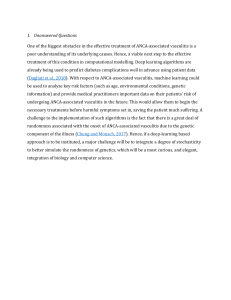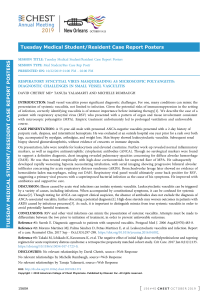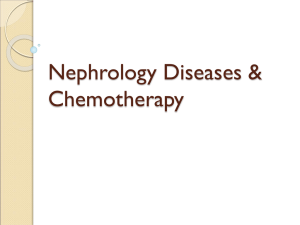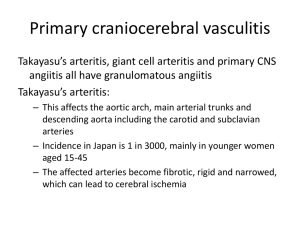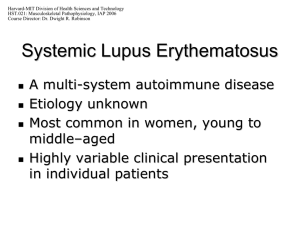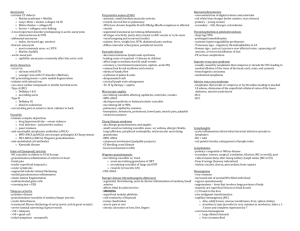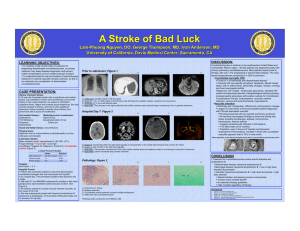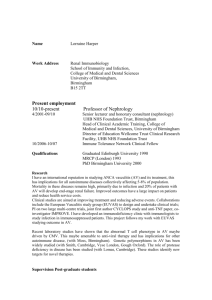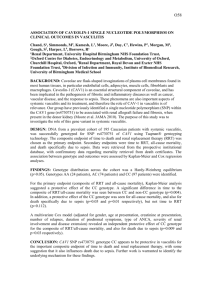August 10, 2012 - Kyle Carpenter
advertisement
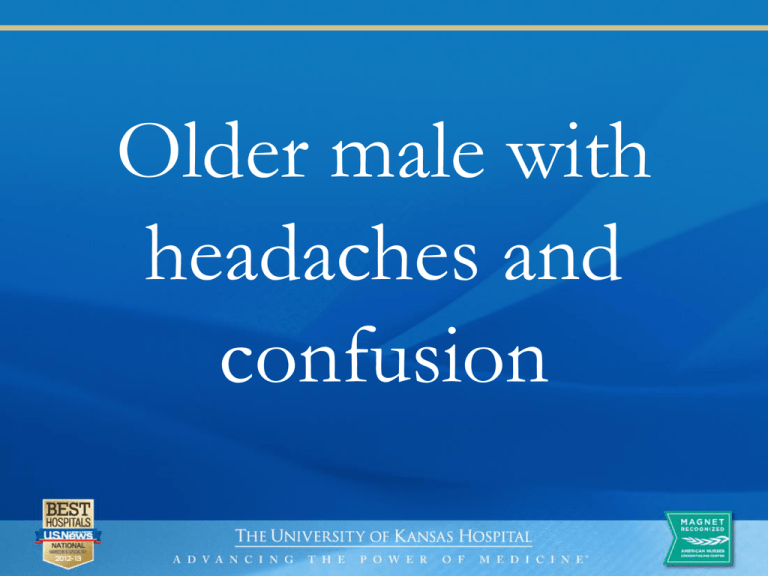
Older male with headaches and confusion History • Middle-aged, right handed Caucasian male no home medications, no PMH • Three week history of low grade fever and frontal headache • Diagnosed by PCP as sinus infection and given antibiotics • With no improvement admitted to OSH – LP: 73 WBC (73% L), 11 RBC, 44 protein. Viral testing and cultures were negative. Discharged home one day later ama as he felt better • Readmitted 5 days later for somnolence and confusion. • CT head: two new low density lesions. MRI: multiple acute infarcts in various distributions • Remote hx of pilonidal cyst removal, smokes 1ppd, no sick contacts Further work up at KU • Infectious – West Nile CSF IgM/IgG, Cryptococcal antigen, Influenza, Monospot, Enterovirus PCR, Hepatitis screen, HIV, VZV, HSV 1/2, Syphilis antibody, bacterial, fungal, viral cultures, T spot • Autoimmune – Rheumatoid factor, C3/C4, ACE, CANCA, P-ANCA, anti-double strand, myeloperoxidase, Serine protease, anti SSA, SSB, ANA screen • Hypercoagable – – Factor V Leiden in one allele (heterozygous) Cardiolipin, protein C & S, antithrombin III, factor 2 mutation • LdL 89, A1C 5.6% • Sed Rate 15, CRP 0.05 • Two LPs with WBC 21-29, protein 41-49 • Paraneoplastic panel negative • No oligoclonal bands, CSF ACE <4, CSF IgG was normal • CSF flow cytometry was negative x2 Imaging • Radiology – IR Arteriogram • Smooth vessels, no evidence of vasculitis – MRI Brain w/wo gadolinium • Patchy areas of subacute ischemia – PET scan • Normal – Transesophageal echocardiogram • unremarkable – CT chest • RLL pulmonary artery clot • Factor V Leiden heterozygous positive 5-10 fold increase in venous thrombosis • Ophthalmology found right eye papilledema but no known cause • Discharged home after five days on coumadin, strokes thought likely to be due to FVL, smoking, athereosclerosis Re-admission • Re-admitted 2 weeks later with new onset imbalance and left arm and leg weakness • Found to have new acute infarcts • Mental status detoriated and transient episodes of hemiplegia upon awakening • Episodes of unresponsiveness, rigid, hypertension, tachycardia and fever. Transferred to ICU and intubated • Started on AEDs and VEEG monitoring. No epileptiform discharges. Thought to have autonomic storming • Eventually had tracheostomy and percutaneous enteral feeding tube placed • Repeat Imaging • Where? • What? • Brain biopsy “Although the changes are not specific or diagnostic of a particular disorder, and while the current biopsy does not contain an infarct, the vascular changes observed would be compatible with a vascular-ischemic disorder, such as vasculitis, a leading clinicoradiological impression. A neoplastic process is not recognized." • • • • Pt started on high dose IV steroids, cytoxan Propanolol for storming Mental status plateaued Discharged to L-TACH 6 weeks after admission CNS VASCULITIS CNS Vasculitis aka Primary Angiitis of the CNS (PACNS) • Inflammation of small and medium sized arteries only in CNS causing CNS dysfunction – Unexplained neurologic or psychiatric deficit – Classic angiographic or histopathologic features – No evidence of systemic vasculitis • Difficult to diagnose and study – Rarity – about 500 cases reported since 1959 – Nonspecific and various presentations – No useful animal models Pathology • Pathologic findings include Langerhans or foreign body giant cells, necrotizing vasculitis or lymphocytic vasculitis • Inflammation causes vessels to become narrowed, occluded and thrombosed • More likely to affect blood vessels in cerebral cortex and leptomeninges more than subcortical regions • Cause is unknown – Infection Mycoplasma gallisepticum, VZV, WNV, HIV have been proposed Clinical Manifestations • Suspected when in patients with recurrent strokes with no identifiable cause or other CNS dysfunction with no cause • Male 2:1 predominance • Mean age is 42 but can occur at any age • Series of 116 patients presented with – 83% had decreased cognition, 56% headache, 30% seizure, 14% stroke, 12% cerebral hemorrhage • Strokes/TIAs occur in 30-50% of patients Differential • • Reversible cerebral vasoconstriction syndrome (Call-Fleming) Systemic vasculitis involving the brain – Behcet’s, polyarteritis nodosa, Wegener’s, Churg-Strauss, cryoglobulinemic vasculitis • Connective tissue diseases – SLE, NAIM, rheumatoid vasculitis, antiphospholipid syndrome • Infections – Varicella zoster, HIV, hepatitis C, CMV, • Atherosclerotic disease – – Premature intracranial, Chronic hypertension • • Demyelinating- MS, ADEM, PML Embolic disease – cardiogenic • Malignancy – Intravascular lymphoma • Miscellanous – PRES, sarcoidosis, Susac, CADASIL, MELAS, moyamoya Testing • • • • ESR and CRP- usually normal Complete infectious and rheumatologic work up Drugs of abuse screen- cocaine CSF- abnormal in 80-90% of patients but no specific abnormalities – Elevated protein and wbc – important to rule out other diseases Imaging • MRI – used frequently in work up to assess for stroke, leptomeningeal enchancement, follow progress of lesions • Angiography: ectasia and stenosis “beading” usually in small arteries with involvement of several sites. – Also has multiple occlusions with sharp cutoffs and circumferential or eccentric vessel irregularities – Two series of patients found sensitivity of 60%. Cannot use negative exam to rule out • Vessels usually beyond resolution of exam Differential Diagnosis of vascular constriction and ectasia/beading Vasospasm Infection Emboli Athereosclerosis Hypercoaguable state Biopsy • • • • Gold standard Sampling of leptomeninges and underlying cortex One case series found 25% false negative Positive – still need to stain for organisms Treatment • Initial- with infection excluded – Glucocorticoids- no trials on route, dose or length of treatment • Biopsy confirmed – Glucocorticoids – Cyclophosphamide- 600-750mg/m2 qmonth for three to sixth months – Once in remission for 3-6 months switch to alternative agents MMF, Azathioprine and MTX – Serial MRIs Conclusion • PACNS is a difficult disease to identify and treat • Should be entertained in patients who have new onset neurologic deficits and multifocal strokes with no other apparent cause • Diagnosis is arrived at by exclusion of other causes and a combination of clinical history, CSF findings, radiologic and pathologic findings
